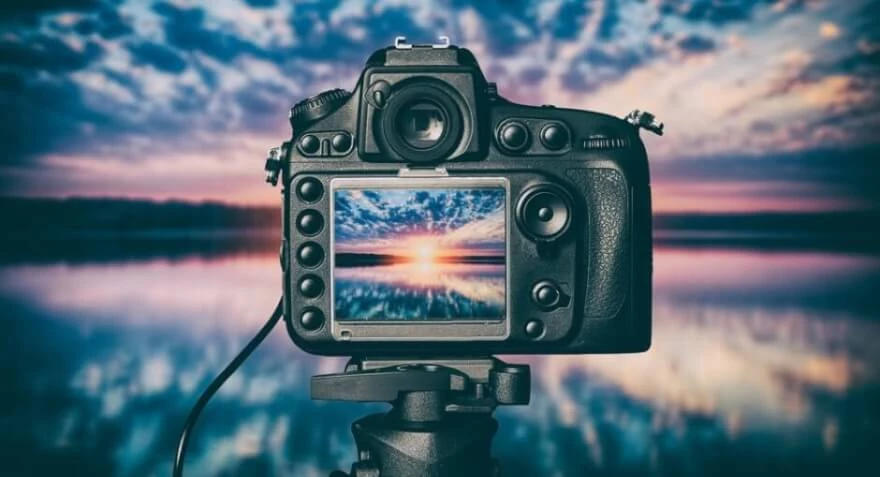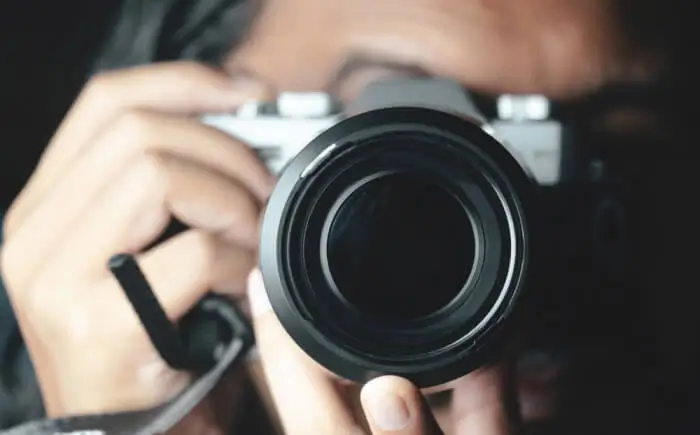What is a viewfinder on a camera?

- What is a mirrored viewfinder?
- What is a viewfinder on a camera if it is electronic?
- Get a perfect depth of field and quality of frames by the EVF
- Focus easily with increased energy consumption by the EVF
- How to choose a camera with optical viewfinder?
- Remember technical limitation of the OVF
- Use professional reviews for pentaprisms and pentamirrors
- Consider image quality issues of EVF and OVF
- Choose the option, matching your needs
The camera viewfinder is an important part of the device, responsible for comfortable sighting and accurate composition of future shots. In modern cameras, there are two fundamentally different classes of viewfinders - optical (used in DSLR) and digital (in compacts and mirrorless cameras). They differ not only in the technical principle of operation; each of them has its characteristics and nuances.

What is a mirrored viewfinder?
DSLR are named because they use a mirror to direct light into the viewfinder.
The light flux through the lens enters the mirror, then is directed to the pentaprism and from there "ricochets'' into the viewfinder. Such a scheme is always used on professional cameras, although recently cheap entry-level SLR cameras have appeared, they also use a mirror viewfinder. The advantages of such a system are more than obvious: the photographer sees in the viewfinder exactly the frame that he is going to capture, without distortion and parallax. It also does not require battery power. There is also a disadvantage, such a system requires space for implementation, so SLR cameras are large and heavy. It is also technically difficult, which implies an increase in the cost of the device.

What is a viewfinder on a camera if it is electronic?
Electronic Viewfinder (EVF) is found in mirrorless and compact cameras. Modern technologies make it possible to remove mirrors and prisms, which are necessary for the operation of the optical viewfinder camera, and transmit the image both to the screen and to the viewfinder of the apparatus by means of an electronic signal. This design makes the compact digital camera with viewfinder smaller and opens up new possibilities for the photographer.
Essentially, an EVF is a small display with an unusually high resolution and pixel density.
Note that an electronic viewfinder on camera has improved significantly in recent years; the image has become more detailed, livelier, and the picture has ceased to slow down. If you tried mirrorless cameras five years ago and you didn't like it, check out the modern Nikon camera with viewfinder. They are equipped with a very high resolution 3.6 megapixel. This means that the image displayed will be more detailed than on the camera display, sharp, and individual pixels will not be visible. In addition, new products have practically no disadvantages, the picture is displayed without delay. When shooting with low light, as well as when working at high ISO, there is no interference, digital noise, the image remains vivid, sharp, bright.

Get a perfect depth of field and quality of frames by the EVF
The fact that the photo is transmitted to the viewfinder already in electronic type carries a lot of advantages. We see a photograph of that brightness and with the colors which it is going to have in the finished scene. You can adjust the exposure and white balance much more precisely, without having to take a lot of test shots. Perfectly adjusted exposure means saving time at the post-processing stage, higher quality of frames, absence of overexposed spots and dips in black in the photo. It is important to note that the EVF exposure simulation can always be turned off when working with pulsed light sources. In addition, any auxiliary tools can be displayed in the electronic viewfinder, for example, a histogram or an electronic level. It is possible to work with focus peaking in manual focusing - this is one of the most convenient manual focusing tools today!
This also includes more visual work with depth of field and bokeh. In the optical viewfinder, it is sometimes difficult to assess what will be sharp in the final photo and what will be blurred. There is no such problem with an electronic viewfinder. It is especially convenient to work with the diaphragm repeater: in the optical viewfinder, it gives a strong darkening of the picture, and in the electronic one the brightness remains at the same level.

Focus easily with increased energy consumption by the EVF
Another plus of the electronic viewfinder is the ability to view the finished material and navigate the camera menu in bright sun. The image is protected from sunlight. When it comes to shooting speed and autofocus speed, a mirrorless electronic viewfinder can also offer new possibilities. A SLR camera always has a so-called blackout during continuous shooting - nothing is visible in the viewfinder at the moment when the mirror rises and the mechanical shutter opens. Therefore, during continuous shooting in the optical viewfinder, the picture disappears and appears. And it disappears not only for the photographer, who finds it more difficult to compose the frame, but also for the autofocus module, which does not work while the mirror is raised. Modern mirrorless cameras allow you to get rid of blackout without extinguishing the image even during shooting, the picture may "freeze" for a moment (and in some models this does not happen!), but does not "blink". This improves the shooting comfort.
New autofocus capabilities are also associated with the use of an electronic viewfinder. Now we can focus anywhere in the frame. This is facilitated by hundreds of phase focusing points, distributed over the entire area of the frame. This also includes focusing with face recognition. In the upcoming Nikon and a Canon camera with viewfinder updates, the developers promise to add eye focusing.
But there is also a minus, shooting with an electronic viewfinder consumes much energy, even more than when sighting on the display. This is due to the fact that when rendering a picture of such a high resolution, which is needed for display, the camera processor is heavily loaded. This makes mirrorless cameras work less on a single battery charge on average.

How to choose a camera with optical viewfinder?
The Optical Viewfinder (OVF) is found in DSLR cameras. The essence of a DSLR is that through a system of mirrors, prisms and lenses, light coming through the lens enters the viewfinder. The photographer sees the same as the camera lens. And at the moment of shooting, the mirror, directing the light into the viewfinder, rises, and the lens projects the image onto the camera sensor.
The optical viewfinder has migrated into modern photographic technology from fully mechanical film cameras. For its operation, almost no electricity is required (it is only needed to highlight the displayed shooting information). This is one of the most important advantages.
Due to the fact that no battery is consumed during sighting, SLR cameras can work on a single charge for a long time. In conjunction with the optical viewfinder, a separate sensitive phase detection autofocus module is used. It is thanks to phase detection autofocus that DSLR focus quickly and accurately in all lighting conditions. A digital camera with viewfinder center AF point sensitivity is −4 EV, which is comparable to the illumination level on a moonlit night outside the city. But there are also limitations associated with the use of a separate autofocus module, the impossibility of covering the entire area of the frame with focus points and the likelihood of back- and front-focusing.

Remember technical limitation of the OVF
Another plus of the optical viewfinder is important for dynamic reportage photography. The absence of electronic components in the design eliminates a delay in the transmission of images due to their imperfections, the image is transmitted to the viewfinder literally at the speed of light!
But there are nuances. We see the image "as in life", and not the one that will end up in the photo. You will not be able to see a picture of the same brightness and visually assess the correctness of the entered exposure and white balance settings. For an experienced photographer, this is not a problem, since he knows how to use the exposure metering scale and is well acquainted with the peculiarities and settings. But for a beginner, this is likely to cause difficulties: the object may turn out darker or lighter than he expected, looking through the glass. Here, we note that due to technical limitations, it will not be possible to display all the shooting information in the optical viewfinder, as it is done on the camera screen. To display information about shooting parameters, a special line is provided at the bottom. To display additional designations directly on top of the image, the viewfinder is complemented with a special LCD display that shows the framing grid, selected focus points, and so on. There is enough information for comfortable shooting, but electronic viewfinders have gone much further in this regard. In a cheap camera with viewfinder, it shows 95-98% of the image area. That is, we will not see the most extreme parts of the frame. This can only be a hassle if you need to compose the shot very tightly, not allowing useless details to appear at the borders (an extremely rare task). In a professional best compact camera with viewfinder the coverage is 100%, we see the entire area of the frame, nothing is cropped.
Optical viewfinders of modern cameras differ from those used in the manual focus era: their focusing screens have a faint and shallow matte finish. It is convenient to frame a frame, but it is difficult to focus manually with high accuracy. Interchangeable focusing screens can be a way out, but not all cameras support this feature.
A camera with a viewfinder and flip screen works by using a flip-down mirror hidden inside the camera glass. This design is rather cumbersome and typical of professional devices. Pros: speed of operation, accurate focusing and sharpness, aperture, flash, saving battery power (except for models where the image is also displayed on the screen). In amateur photography, it is inconvenient to use a SLR camera due to its weight, impressive size and many manual settings.

Use professional reviews for pentaprisms and pentamirrors
If you need a camera for traveling in sunny countries, where general previews will be the main photos, then choose an optical viewfinder - charge less often, shooting buttons are easy, the image is clearer with almost no need for correction.
If you want to buy a camera for shooting at short distances (home holidays, baby photos, images for product reviews), then opt for an electronic option by Fuji or OLED Sony camera with viewfinder.
If you are planning a serious photo job, then consider the option of a DSLR.
There are cameras that have no viewfinder at all. They look like a digital viewfinder camera because the LCD does this, so be careful.

Consider image quality issues of EVF and OVF
Several factors in total affect the quality of a photo: resolution (or megapixels), sensor size, crop factor and sensor technology. The matrix consists of sensors that light falls on. The more light hits the sensors, the more juicy, clear and natural the images will be. Basically, the number of sensors is equal to the number of pixels. And here's the attention: an increase in the number of pixels, that is, sensors on a matrix of the same size, leads to a deterioration in the image quality. This happens because less light falls on each sensor, plus the camera is not always stationary (additional interference) and it does not transmit information correctly. The worse the lighting and more pixels on a small sensor, the worse the quality of the photo.
The compactness of the camera is just achieved by reducing the size of the matrix, and hence the sensors. Therefore, when choosing a camera, one should look at the size of the matrix, and not the number of megapixels.

Choose the option, matching your needs
Like many other aspects of photography, there is no definitive answer to the question which viewfinder is better. But the answer lies in the photographer himself. Which viewfinder is right for you specifically, and not for someone else. Some prefer the analog precision of an optical viewfinder, while other high-tech features, offered by electronic options. But another thing is significant, it is important to have the right tool for the job. And if you prefer one kind of another, then just use it.
If your opinion about electronic viewfinders was formed a few years ago, then perhaps you should reconsider it. Electronic viewfinders have made significant progress in their development. And the electronic viewfinder on a five-year-old camera is not at all the same as on new cameras. Therefore, when choosing a new camera in a store, it is worth looking at one of the new models. And make an informed conclusion yourself, what you need and what you don't.
Co-founder of RetouchMe. In addition to business, he is passionate about travel photography and videography. His photos can be viewed on Instagram (over 1 million followers), and his films can be found on his YouTube channel.
Moreover, his profile is featured on the most popular and authoritative resource in the film industry — IMDb. He has received 51 international awards and 18 nominations at film festivals worldwide.

with RetouchMe














